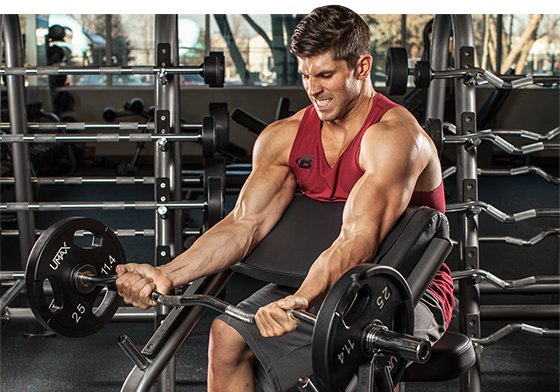Monday: chest. Tuesday: shoulders. Wednesday: back. Thursday: bis and tris, Friday: legs. Sound familiar? It's easy to get into a routine but, after a while, a routine can get, well, old. While they were helpful at the start, those standard six sets of six reps might not cut it anymore.
To see extraordinary results, you need to take measures above and beyond the typical training setup most people use. Are you ready to speed up change and break away from being just another person at the gym? The following five alpha training tips will do just that. Don't attempt to try these all at once, but rather, add them individually to your program as you progress.
1
Try the Pause-and-Hold Technique
With this technique, you move through your standard exercise—whether it be curls, pull-downs, or leg extensions—by executing the number of reps you had planned. Then, once you near a point of full fatigue toward the end of the set, pause and hold the weight at the midway point of the exercise for 2-3 seconds (or however long you can) before doing your best to finish your last rep. Then rest.
This will train your body to work through fatigue. At the same time it stimulates your nervous system, forcing it to maintain muscle contraction intensity when close to the state of exhaustion. Using this technique will help you progress to higher weight levels for standard sets.

2
Implement Giant Sets
Giant sets are not only a great way to work your muscles to a larger extent, but also carry the added bonus of getting in some cardiovascular benefits along the way.
With a giant set, you perform three exercises back-to-back-to-back without taking rest breaks. To structure this to maximum effectiveness, consider doing one upper body exercise, one lower body exercise, and one smaller muscle group exercise incorporating muscles utilized during either of the previous two movements. For example, you might do a bench press followed by a lunge followed by a triceps extension. Or, you could do a bent-over row followed by a leg press followed by a biceps curl.
This non-stop workout will bring about a high state of fatigue in the body. For that reason, instead of doing this for every exercise you do, incorporate no more than one or two giant sets per workout.
3
Perform Partial Reps
Partial reps induce a high level of muscle fatigue and ensure that you reach the point of full exhaustion needed for accelerated muscle development.
With partial reps, you perform one or more sets using the full movement pattern, and then cut back on your range of motion for another 5-10 reps. For example, if you're on the bench press, your first sets would go to full extension, while the next may only involve only coming down 6 inches before extending again. Once those shortened reps are completed, do a couple more full-range reps to finish off the set.
Partial reps take some getting used to, so give your body the time it needs to adapt. Begin by focusing on proper technique rather than sheer quantity. Due to the high level of fatigue build-up, this is one technique where many people will end up resorting to poor form in the attempt to squeeze out just a few more reps. Avoid this scenario at all costs.
If fatigue sets in, stop. Continuing to push on will just lead to improper form, lack of results, and possible injury.
4
Make Your Last Set a Dropset
The dropset is another advanced technique that makes a great addition to any alpha training program. This technique is designed to push you past the fatigue barrier and get your muscles contracting harder than they otherwise would.

With a dropset, you'll want to perform one standard set using the weight you typically lift. Then, once that set is finished, immediately scale the weight back by 5-10 pounds. After you complete your second set, drop the weight once more before finishing up your final set.
5
Practice the Rest-Pause Technique
The fifth technique you'll want to consider using is rest-pause. With this technique, first perform a standard set to completion. Upon hitting fatigue, rest for 10 seconds to regain some degree of energy. After the brief pause, aim to perform 2-3 more reps to finish off the exercise. If possible, this technique should always be done with a spotter since the last few reps after the pause will be extremely intense, increasing your risk of dropping the weight.

